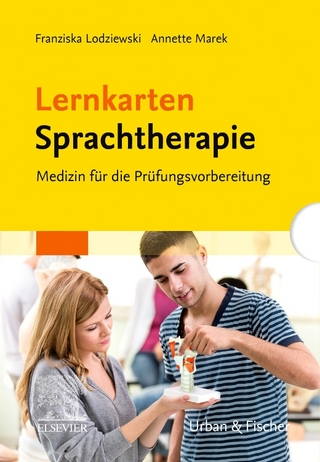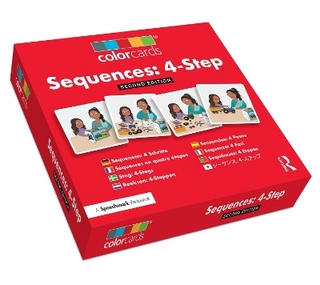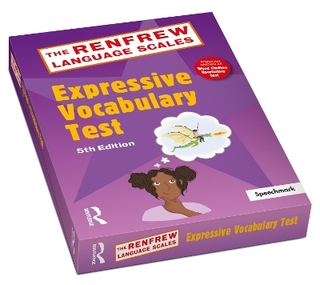
Treatment Resource Manual for Speech Language Pathology, International Edition
Delmar Cengage Learning
978-1-4354-9664-4 (ISBN)
- Keine Verlagsinformationen verfügbar
- Artikel merken
TREATMENT RESOURCE MANUAL FOR SPEECH-LANGUAGE PATHOLOGY, International Edition is an ideal text for students entering into a clinical practicum. Not only are basic therapy and information reporting techniques discussed, but intervention strategies for working with unique child and adult client populations are covered in a well-written and concise manner. The new edition has been completely revised and contains significantly expanded information on language disorders in children including early intervention, coverage of the response-to-intervention (RTI) service delivery model, metalinguistic skills, and appropriate instructional strategies for the development of writing skills. An expanded discussion of issues in articulation and phonology disorders including treatment models and goal selection strategies is also included. Updated references, evidence-based practice, and additional resources are provided for all chapters, making the fourth edition of Treatment Resource Manual for Speech-Language Pathology the most comprehensive text available on the treatment of communication disorders.
Froma P. Roth, Ph.D., is a professor in the department of hearing and speech sciences at the University of Maryland, College Park. She received her bachelor's degree from Hunter College, her master's degree from Queens College, and her doctoral degree from the Graduate Center of the City University of New York. Dr. Roth's current research interests focus on the relationship between oral language development and early reading and writing acquisition, phonological awareness intervention for preschool children with primary speech and language deficits, and language and literacy development in children with cochlear implants. Colleen K. Worthington, M.S., is director of the speech-language clinic in the department of hearing and speech sciences at the University of Maryland, College Park. She received her bachelor's degree from the University of Maryland and her master's degree from Loyola College, Baltimore. Her primary clinical and research interests include language development, phonology, and the supervisory process, including investigating the effectiveness of commercially available phonological awareness intervention programs.
List of Tables.
Case Examples by Disorder.
List of Forms and Figures.
Preface.
Acknowledgments.
About the Authors.
PART I: PREPARING FOR EFFECTIVE INTERVENTION.
1. The Essential Ingredients of Good Therapy: Basic Skills. Philosophy. General Principles of Intervention. Universal Design Principles for Learning. Programming. Selection of Therapy Targets. Sequencing of Therapy Targets. Generalization/Carryover. Termination of Therapy. Formulation of Behavioral Objectives. Behavior Modification. Types of Reinforcement. Schedules of Reinforcement.
Key Teaching/Scaffolding Strategies. Homework. Session Design. Basic Training Protocol. Task Order. Dynamics of Therapy. Group Therapy.Service Delivery Models in Educational Settings. Collaboration Partnership. Response To Intervention Approach Data Collection. Recording Session Data. Probes. Treatment Efficacy and Evidence-Based Practice
Setting-Specific Professional Terminology. (NOTE: this should be the same level header as Data Collection or Treatment Efficacy) Troubleshooting Tips for Therapy Sessions. Conclusion.
Additional Resources.
Appendix 1-A: Therapy Observation Checklist.
Appendix 1-B: Worksheet for Identifying Behavioral Objectives.
Appendix 1-C: Worksheet for Formulating and Writing. Behavioral Objectives.
Appendix 1-D: Sample Daily Therapy Plan.
Appendix 1-E: Daily Therapy Plan.
Appendix 1-F: Report of Observation Hours.
Appendix 1-G: Instructions for Using Data Recording Forms.
2. Information Reporting Systems and Techniques.
Philosophy. Technical Writing Style. Report Formats. Initial Therapy Plan. Progress Notes. Progress and Final Reports. Tips for Proofreading Clinical Reports Individualized Educatio. Professional Correspondence. HIPAA
Additional Resources.
Appendix 2-A: Health Information Portability and Accountability Act (HIPAA.)
Appendix 2-B: Sample Initial Therapy Plan.
Appendix 2-C: Sample Progress Report.
PART II: PROVIDING TREATMENT FOR COMMUNICATION DISORDERS.
3. Intervention for Articulation and Phonology in Children. Treatment Efficacy/Evidence-Based Practice. (Expanded discussion). Target Selection Strategies for Intervention Programming. (Expanded discussion). Oral-Motor Considerations. (Expanded discussion). Hierarchy of Oral-Motor Treatment Steps.
Functional Articulation Disorders. Example Profiles. Organic Articulation Disorders. Cleft Palate. Example Profile. Hearing Impairment. Example Profile. Childhood Apraxia of Speech (Expanded discussion). Example Profile. Phonological Disorders. Example Profiles. Conclusion.
Additional Resources.
Appendix 3-A: Phonetic Placement Instructions for Difficult-to-Teach Sounds.
Appendix 3-B: Diadokinetic Rates for Children.
4. Intervention for Language in Infants and Preschool Children. Classification of Language Disorders. Relationship between Oral Language and Literacy. Role of the Speech-Language Pathologist in Literacy. Discussion of EBP. Treatment.Intervention with Infants (Birth to 2 Years). (Expanded discussion to include new ASHA EI guidelines). Intervention with Children (2 to 5 Years). Emergent Literacy Intervention (Birth through Preschool Years). (Expanded discussion). Example Profiles.Conclusion.
Additional Resources.
Appendix 4-A: Developmental Language Milestones: Birth to 5 Years.
Appendix 4-B: Stages of Play Development.
Appendix 4-C: Developmental Toy List.
5. Intervention for Language in School-Age. Children through Adolescence.
New discussion of RTI and UDL. New discussion of EBP for school-age and adolescents. Treatment for School-Age Children. Example Profiles. Intervention with Adolescents (10 to 18 Years). (Expanded discussion of metacognitive/executive functioning). New discussion of SLP's role in reading comprehension and writing instruction with summary table of specific approaches. Example Profiles. New discussion of transitional Issues. Conclusion.
Additional Resources.
Appendix 5-A: Types of Cohesion.
6. Intervention for Adult Aphasia, the Dysarthrias, and Apraxia of Speech (with Introduction to Dysphagia). Aphasia: Classification of Aphasia Syndromes. Treatment Efficacy/Evidence-Based Practice. (Expanded discussion) Treatment for Aphasia. Example Profiles. Conclusion. Treatment for Motor Speech Disorders. The Dysarthrias. Classification of the Dysarthrias. Treatment Efficacy. Treatment for the Dysarthrias. (Expanded discussion). Example Profiles. Apraxia of Speech. Treatment Efficacy. (Expanded discussion). Treatment for Apraxia of Speech. Example Profiles. Introduction to Dysphagia. Treatment. Conclusion.
Additional Resources.
Appendix 6-A: Glossary of Selected Medical Terms.
Appendix 6-B: Suggestions for Enhancing Verbal Interaction with an Aphasic Family Member.
Appendix 6-C: Guidelines for Conversational Coaching.
Appendix 6-D: Normative Data for Adult Diadochokinetic Rates.
7. Intervention for Fluency. Categories of Stuttering Behaviors. Core Behaviors. Secondary Behaviors. Developmental Disfluencies versus Stuttering. Treatment. Treatment Efficacy/Evidence-Based Practice. (Expanded discussion) Intervention Techniques. Example Profiles. Conclusion.
Additional Resources.
Appendix 7-A: Sample Phrases, Questions, and Monologues.
8. Intervention for Voice and Alaryngeal Speech. Voice Disorders. Classification of Voice Disorders. Treatment Efficacy/Evidence-Based Practice. (Expanded discussion). Treatment. Intervention Techniques. Example Profiles. Alaryngeal Speech. Treatment.
Mechanical Devices. Esophageal Speech. Tracheoesophageal (TE) Speech. Example Profile. Conclusion.
Additional Resources.
Appendix 8-A: Additional Dialogue Scripts for Voice Therapy Activities.
9. Client and Family Counseling. Stages of Counseling. Establishing the Therapeutic Relationship. Implementing Counseling Intervention. Terminating the Therapeutic Relationship. Client and Family Emotional Reactions to Communicative Disorders.
Counseling Techniques for Communicative Disorders. (Expanded discussion) Group Counseling. Family Systems Counseling. Conclusion.
Additional Resources.
10. Multicultural/ELL TREATMENT Issues. Conclusion.
Additional Resources.
Appendix A: Scope of Practice in Speech-Language Pathology.
Appendix B: Code of Ethics of the American Speech-Language-Hearing Association.
Appendix C: Multicultural Tables.
Appendix D: International Phonetic Alphabet Symbols.
References.
Index.
| Verlagsort | Clifton Park |
|---|---|
| Sprache | englisch |
| Maße | 215 x 274 mm |
| Gewicht | 953 g |
| Themenwelt | Medizin / Pharmazie ► Gesundheitsfachberufe ► Logopädie |
| Medizin / Pharmazie ► Medizinische Fachgebiete ► Psychiatrie / Psychotherapie | |
| Schlagworte | Sprachtherapie |
| ISBN-10 | 1-4354-9664-7 / 1435496647 |
| ISBN-13 | 978-1-4354-9664-4 / 9781435496644 |
| Zustand | Neuware |
| Haben Sie eine Frage zum Produkt? |
aus dem Bereich


